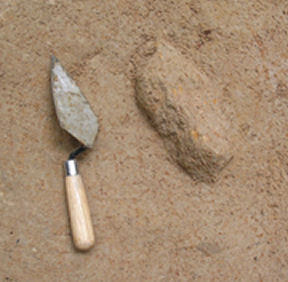Chimpanzee Stone Age: Finds in Africa rock prehistory of tools
Working along a riverbank in a West African rain forest, researchers have uncovered remnants from a chimpanzee stone age that started at least 4,300 years ago. The finds constitute the only evidence yet detected of prehistoric ape behavior.

Most of the more than 200 stone artifacts found at three sites in Taï National Park, Ivory Coast, were used by prehistoric chimps to crack open nuts, say archaeologist Julio Mercader of the University of Calgary in Alberta and his colleagues. The animals placed nuts on the flat surface of one rock and smashed the tough shells with another rock.
“I’d predict that this type of simple bashing technology goes back to a common ancestor of chimps and humans around 6 million years ago,” Mercader says.
His team presents its findings in the Feb. 27 Proceedings of the National Academy of Sciences.
The researchers excavated a cluster of three sites in 2001 and 2003. Most of the stone artifacts came from one location, known as Noulo. Radiocarbon measurements of burned wood in the soil produced the age estimate for the finds.
To see whether the artifacts could be distinguished as implements, Mercader and two of his coauthors, both well-recognized specialists in Stone Age tools, assessed a group of 90 stones, not knowing beforehand their origins: the West African sites, a 5,000-year-old human occupation in Canada, or a location in the Canadian Rockies where the stones had been modified only by geological forces. In almost all cases, the three examiners identified just the stones from the first two groups as being intentionally modified.
Turning to the full set of specimens from the three West African sites, the scientists concluded that most represent instances of one stone being hammered forcefully against another. Those rocks weighed from 1 kilogram to 9 kilograms (2.2 to 19.8 pounds).
The team also judged that people had apparently struck flakes off 28 of the stones. People probably visited the frequently flooded riverbank sites sporadically, Mercader posits.
Other clues suggest that chimps, rather than people, had used the unflaked stones, For instance, large, heavy hammering stones at Noulo look like those that chimps at a nearby site use to crack nuts (SN: 3/30/02, p. 195: Wild Chimps Rocked On: Apes left unique record of stone tools). Both the old and modern sets of artifacts contain small pits and hollow depressions produced by bashing rocks together, as well as distinctive edge and corner damage.
Finally, starch grains extracted from 31 stones at the West African sites came predominantly from nuts typically eaten only by chimps, according to Mercader’s team. People living in that part of the rain forest mainly subsist on tubers, plants, and fruits. The sites yielded none of the pounding and grinding tools favored by foragers and farmers.
The new finds precede the emergence of farming villages in that part of Africa. Mercader notes that it’s possible that chimps imitated simple stone-tool practices of human foragers. Still, he suspects that the rock-bashing activity originated deep in prehistory.
Archaeologist Alison S. Brooks of George Washington University in Washington, D.C., agrees: “There is no reason why future work should not reveal evidence of even older chimpanzee sites.” Starch grains last well over 100,000 years, Brooks notes.
Although the new data make “a fairly solid case” for prehistoric nut cracking by chimps, the animals probably invented this stone-tool technique on their own rather than inheriting it from a common human-chimp ancestor, remarks archaeologist John J. Shea of the State University of New York at Stony Brook.







